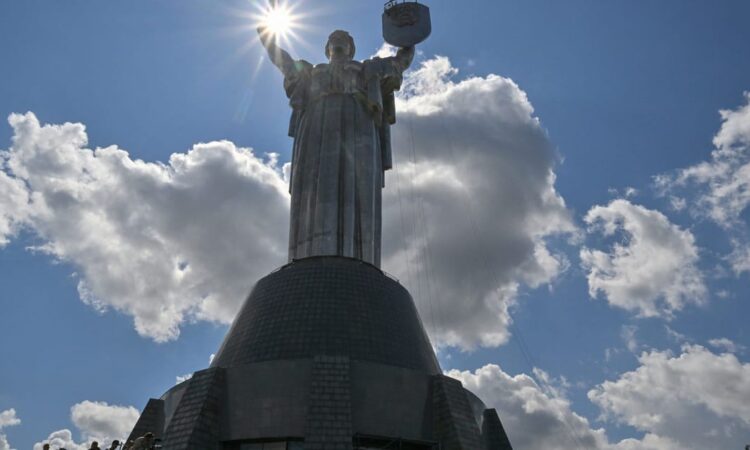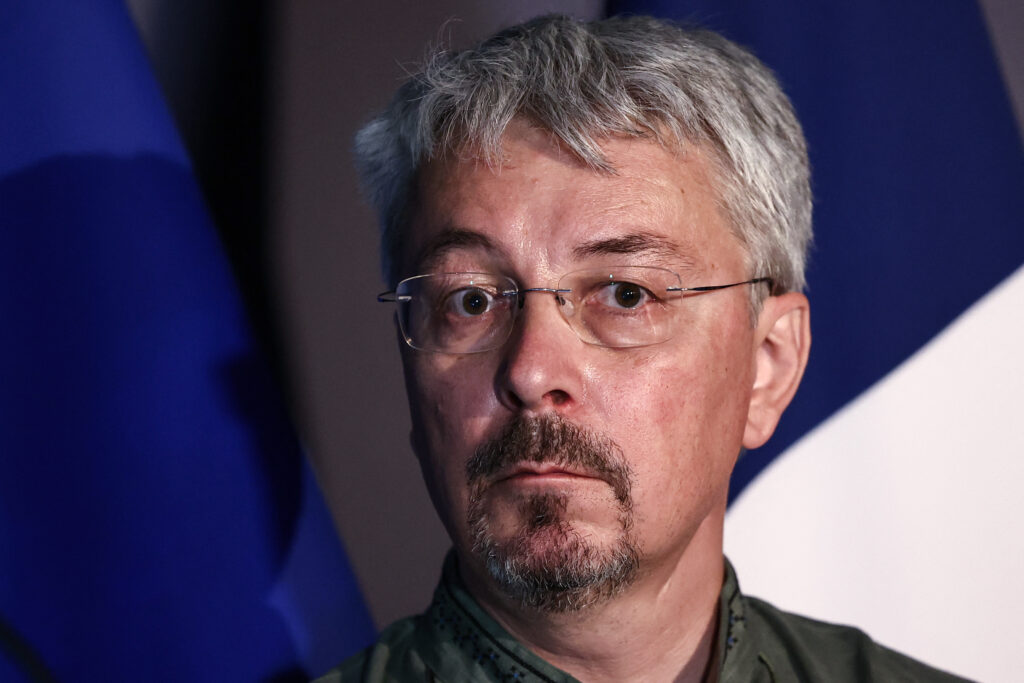
Press play to listen to this article
Voiced by artificial intelligence.
KYIV — Ukrainians are always looking for ways to give the middle finger to Russia. But many locals are now asking if radically altering the iconic Motherland monument to remove a hammer and sickle is the best way of using the country’s wartime resources.
The 62-meter-tall statue of a woman — affectionally known locally as Baba — has stood atop a hill on the right bank of Kyiv since 1981. Sternly looking east, she holds a 16-meter-long sword in her right hand and an eight-meter-long shield in her left. But there’s a problem for a country at war: on the shield are the hammer and sickle, the symbols of the industrial worker and the peasant used as the emblem of the former Soviet Union.
On Sunday, workers started dismantling the Soviet emblem — piece by piece.
“We wanted to watch, but they did not allow us to come close for security reasons,” Viktoria Andrienko, a Ukrainian woman who arrived to watch the dismantling process with her family on Monday, told POLITICO. “She [the statue] is a symbol. I support this decision, but it is long overdue. They should have done it long ago.”
Earlier in July, the Ukrainian government decided the time had come to change the gigantic symbol of Soviet rule over Ukraine and replace the hammer and sickle with the coat of arms of Ukraine, a trident.
“There is serious public demand for the process of overcoming the consequences of Sovietization, Russification of Ukraine,” Oleksandr Tkachenko, now Ukraine’s former culture minister, said earlier this month.
“We’ve been working on this project since last year when 85 percent of Ukrainians supported the change via online voting,” he added. Tkachenko resigned earlier in July following a call for spending restraint by Ukrainian President Volodymyr Zelenskyy. Tkachenko was a proponent of several high-profile and costly projects.
However, not all Ukrainians think spending money on an anti-Russia gesture is a good idea as Moscow ramps up its drone and weapon production.
Ukrainian combat medic Viktor Prylypenko said work to alter the Motherland monument was “definitely impractical” as “the army has a significant shortage of strike and reconnaissance drones. Such spending also has a negative effect on the morale of soldiers. This is not a street renaming, which only costs a penny” but rather “costs millions of hryvnias.”
The view from the frontline, said Prylypenko, is that changing the statue is “a waste of money.”
“It is also a symptom of the lack of creating a state military strategy for civilian spending,” he added. “We see how statesmen often go abroad to ask not only for weapons, but also for financial assistance, and right away, we see the waste of taxpayers’ money. If there was a strategy, we would see news on our channels about the inventions of our scientists for the military, the launch of production lines for domestic military equipment, the construction of reliable shelters … the involvement of businesses in the construction of shelters in residential complexes, the opening of local production lines for basic things such as masks, which are still woven by the hands of volunteers, the creation of quick-installation dugout modules, female engineers, etc.”
The Ministry of Culture and Information Policy has said repeatedly the state has not spent a single hryvnia on the project, which is estimated to cost 28 million hryvnias (around €700,000), and that cash is coming from big businesses.
That has dampened the outrage, if only a little.
“So, if it is not money from the budget it means you can spend it anyhow you want? This is €700,000. This is more than 2,000 FPV drones, for example, or 240 sniper rifles, 350 thermal imagers of good quality, or much more. Why changing the coat of arms of the USSR to a trident right now is a more urgent need than strengthening the technical support of the army is a mystery to me,” Diana Stavska, a dentist from Kyiv, who also buys supplies from volunteers for the Ukrainian army, wrote in a Facebook post.
Tkachenko the fall guy
Following a wave of public outrage about excessive government spending, Zelenskyy issued a video statement on July 20 urging the government to fire Tkachenko.
“Museums, cultural centers, symbols, TV series — all this is important, but now we have other priorities. Find non-budgetary funds. The state must focus its maximum attention on defense needs,” Zelenskyy — himself a former TV star — said in the statement.

Tkachenko, who said he resigned before the president urged his firing, was defiant until the last. “Some say it is not the time to spend money on culture during the war. But tell me then, what are we fighting for? Aren’t we fighting for our culture, identity, language, and history? Culture during the war is as important as drones,” he said in a statement on Friday, the same day the Ukrainian parliament approved his resignation.
According to the Ministry of Culture, Metinvest Group, owned by Rinat Akhmetov — Ukraine’s wealthiest man and owner of football club Shakhtar Donetsk — is going to make the trident to be held by the Motherland monument, as well as one of the financial partners for the project. The steel for the trident was supposed to come from the local firm Zaporizhstal but on July 25 the ministry said European steel be used instead as the local steel did not meet the technical requirements.
Zaporizhstal protested the decision, claiming its steel is perfectly suited for the job. “We believe that steel produced at Ukrainian factories should be used in such majestic symbols as a symbol of resistance to aggression,” Zaporizhstal said in a statement.
While people are fighting over her, Motherland Monument still dominates the skyline over Kyiv, the howling of the frequent air raid sirens bouncing back from her steel skin.






